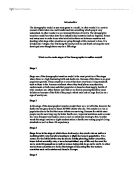During stage 2 the birth rate remains high but the death rate starts to fall to about 20 per 1000 people. By the end of this stage there is a large difference between the birth rate and the death rate. This gives a high natural increase and a rapid growth in population live.
This results from:
- Improved medical care including vaccination, hospitals and medicines.
- Cleaner water supplies and improved sewage facilities.
- An improvement in the quality and the quantity of food supplies.
The UK passed through stage 2 during the industrial revolution between 1750 and 1900. At this time new medicines were being discovered and people learned about the importance of hygiene and cleanliness. In the UK, water mains and sewerage systems began to be built in many of the growing towns and cities. The same developments are taking place in many developing countries today, although some of the poorest such as Bangladesh and Nigeria are still in the early stage 2 of the population cycle.
Stage 3 – The birth rate starts to fall
The death rate continues to fall but more slowly, to about 15 per 1000, but the most important change is in the birth rate. The birth rate also starts to fall, to about 20 per 1000 population. This means there is still high natural increase but the population growth begins to slow down. The birth rate begins to fall due to:
- Introduction of family planning and birth control.
- Improvement of medical care so that fewer children die (lower infant mortality) and there is less need to have such larger families.
- More people in cities where it costs more to support children, while fewer people live and work on farms, requiring less labour.
- The materialistic society in which people are more interested in buying TV’s fridges and motor bikes then in having large families.
- The provision in developed countries of state old age pensions, so that old people are not dependant on their children for support in old age.
- More women staying in higher education, marrying later and pursuing careers.
The UK passed through stage 3 between about 1900 and 1950. Today many LEDCs are in stage 3, e.g. Argentina and Brazil. China has also moved into stage 3 as a result of the government’s one – child policy, which has reduced the birth rate from over 30 per 1000 in 1960 to 18 per 1000 in 1994.
Stage 4 – Birth and Death rates are both low
In stage 4 the death rate and the birth rate are both low, although both may fluctuate slightly from year to year. This gives a very low natural increase or a steady population. Many MEDCs, such as countries of Europe, the USA and Japan, are at stage 4 today.
If all the countries in the world were at stage 4 then zero population growth would be much closer. Many people hope that world zero population growth is achieved before too long. They are worried about the speed at which the Earth’s resources are being used up, about levels of pollution and about how the ever-growing population will be fed, clothed and housed.
Types of Migration
Permanent Temporary
International Internal
(Between Countries) (Within a country)
VOLUNTARY, e.g. FORCED (refugees) SEASONAL DAILY
For work, “ brain e.g. slave trade e.g. tourism shops
work, “ brain drain”, and Afghans fruit – picking
escape poverty. and university
students
Urban to rural Rural to urban
e.g. retirement and e.g. searching for
counter urbanization employment








